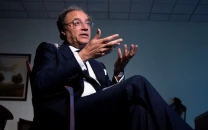Costly cure for hepatitis C
The Sofosbuvir treatment is a 12-week course estimated to cost about $84,000 in rich countries like the US.

The writer is a development consultant and holds a PhD in Development Anthropology from Melbourne University syed.ali@tribune.com.pk
The development of this effective new drug can potentially offer a new lease on life to as many as 200 million people who are estimated to be infected by the hepatitis C virus around the world. However, just because a new drug has been developed, does not mean that it will actually reach those who are in need of a cure. The exorbitant price of this new drug poses a major hurdle.
The Sofosbuvir treatment course is meant to last 12 weeks and is estimated to cost about $84,000 in rich countries like the US, not counting the cost of its necessary companion drugs. Sofosbuvir’s treatment cost is thus four times more than other less effective drugs such as Interferon. Critics who question whether this price tag represents fair profit needed to spur innovation, estimate the actual cost of a course of administering the Sofosbuir treatment to be around $150 to $250 per person. One reason being cited for the drug being priced so high is that Gilead, the pharmaceutical giant which has developed Sofosbuir, had to pay $11 billion to acquire Pharmasset, the original maker of the drug.
Gilead representatives have issued statements claiming their company is committed to making this medicine available to patients regardless of where they reside or their level of incomes, and that it is working with advocates in communities affected by hepatitis C to develop appropriate access and pricing strategies, especially in resource-limited countries with high hepatitis C infection rates.
One hopes that policymakers and other public health sector stakeholders in Pakistan are paying attention to these developments. It was only last month, on the sidelines of the American Association of Liver Disease conference, that a number of international researchers and physicians called upon Pakistan’s health officials to declare a hepatitis C emergency, since an estimated 9.4 million Pakistani patients are suffering from the deadly disease.
What Gilead will end up charging for a course of the drug in countries like India, Pakistan and Egypt, where most people with hepatitis C are found, remains to be seen. The Médicins Sans Frontières (MSF) advocates the need for affordable medicines in resource-strapped communities, and it is waiting for Gilead to finalise its ‘access strategy’ for poor countries. However, there is little optimism that the reduced price will be low enough to make the drug widely accessible. The MSF has pointed out that Gilead is likely to charge ‘middle-income’ countries — like China, Iran and Ukraine — higher prices, despite the fact that 75 per cent of the world’s poor reside in such countries.
Despite contentions surrounding the development of generic drugs to treat HIV and cancer by countries like Brazil and India, most governments still preserve patents assuring huge profits for pharmaceutical companies at the cost of undermining public health. Entities like the WTO and the WHO must make serious efforts to curb the hyper-commoditisation of pharmaceuticals which allows vital medicines to remain out of the reach of the poor.
Published in The Express Tribune, January 3rd, 2014.
Like Opinion & Editorial on Facebook, follow @ETOpEd on Twitter to receive all updates on all our daily pieces.















COMMENTS
Comments are moderated and generally will be posted if they are on-topic and not abusive.
For more information, please see our Comments FAQ